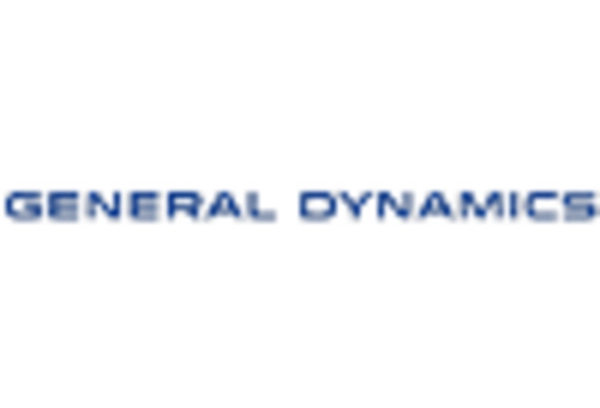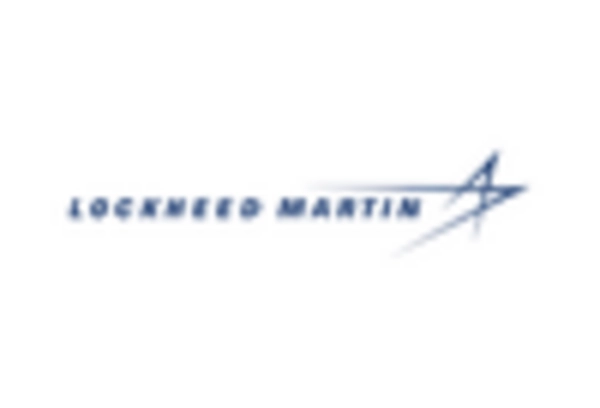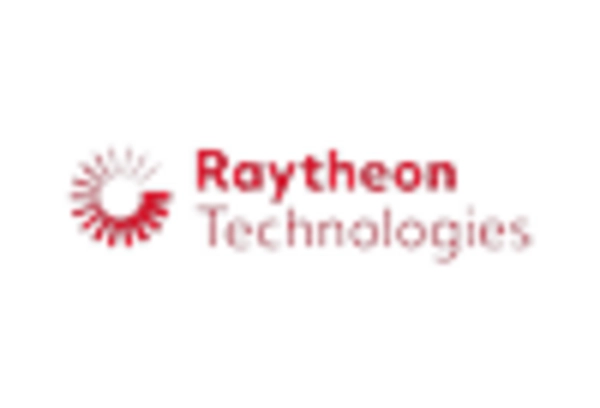Sensors & Actuators
Optical
Memory
Microcontrollers
Logic & Discrete Power Devices
Others
Plastics
Ceramics
Surface-Mount Technology (SMT)
Through-Hole Technology (THT)
Ruggedized Communications
Imaging and Radar
Smart Munitions
Space
Others
Defense
Communication and Navigation Systems
Integrated Vehicle Systems
High Precision Systems
Military Vehicles
Other
Aerospace
Power Payload
Power Management
RF Systems
Avionics
Aircraft
Others
North America Semiconductor in Military and Aerospace by ComponentsSensors & Actuators
Optical
Memory
Microcontrollers
Logic & Discrete Power Devices
Others
North America Semiconductor in Military and Aerospace by Packaging TypePlastics
Ceramics
North America Semiconductor in Military and Aerospace by TechnologySurface-Mount Technology (SMT)
Through-Hole Technology (THT)
North America Semiconductor in Military and Aerospace by ApplicationRuggedized Communications
Imaging and Radar
Smart Munitions
Space
Others
North America Semiconductor in Military and Aerospace by End UserDefense
Communication and Navigation System
Integrated Vehicle Systems
High Precision Systems
Military Vehicles
Others
Aerospace
Power Payload
Power Management
RF Systems
Avionics
Aircraft
Others
US Semiconductor in Military and Aerospace by ComponentsSensors & Actuators
Optical
Memory
Microcontrollers
Logic & Discrete Power Devices
Others
US Semiconductor in Military and Aerospace by Packaging TypePlastics
Ceramics
US Semiconductor in Military and Aerospace by TechnologySurface-Mount Technology (SMT)
Through-Hole Technology (THT)
US Semiconductor in Military and Aerospace by ApplicationRuggedized Communications
Imaging and Radar
Smart Munitions
Space
Others
US Semiconductor in Military and Aerospace by End UserDefense
Communication and Navigation System
Integrated Vehicle Systems
High Precision Systems
Military Vehicles
Others
Aerospace
Power Payload
Power Management
RF Systems
Avionics
Aircraft
Others
Canada Semiconductor in Military and Aerospace by ComponentsSensors & Actuators
Optical
Memory
Microcontrollers
Logic & Discrete Power Devices
Others
Canada Semiconductor in Military and Aerospace by Packaging TypePlastics
Ceramics
Canada Semiconductor in Military and Aerospace by TechnologySurface-Mount Technology (SMT)
Through-Hole Technology (THT)
Canada Semiconductor in Military and Aerospace by ApplicationRuggedized Communications
Imaging and Radar
Smart Munitions
Space
Others
Canada Semiconductor in Military and Aerospace by End UserDefense
Communication and Navigation System
Integrated Vehicle Systems
High Precision Systems
Military Vehicles
Others
Aerospace
Power Payload
Power Management
RF Systems
Avionics
Aircraft
Others
Europe Semiconductor in Military and Aerospace by ComponentsSensors & Actuators
Optical
Memory
Microcontrollers
Logic & Discrete Power Devices
Others
Europe Semiconductor in Military and Aerospace by Packaging TypePlastics
Ceramics
Europe Semiconductor in Military and Aerospace by TechnologySurface-Mount Technology (SMT)
Through-Hole Technology (THT)
Europe Semiconductor in Military and Aerospace by ApplicationRuggedized Communications
Imaging and Radar
Smart Munitions
Space
Others
Europe Semiconductor in Military and Aerospace by End UserDefense
Communication and Navigation System
Integrated Vehicle Systems
High Precision Systems
Military Vehicles
Others
Aerospace
Power Payload
Power Management
RF Systems
Avionics
Aircraft
Others
Germany Outlook (USD Million, 2018-2030)
Germany Semiconductor in Military and Aerospace by ComponentsSensors & Actuators
Optical
Memory
Microcontrollers
Logic & Discrete Power Devices
Others
Germany Semiconductor in Military and Aerospace by Packaging TypePlastics
Ceramics
Germany Semiconductor in Military and Aerospace by TechnologySurface-Mount Technology (SMT)
Through-Hole Technology (THT)
Germany Semiconductor in Military and Aerospace by ApplicationRuggedized Communications
Imaging and Radar
Smart Munitions
Space
Others
Germany Semiconductor in Military and Aerospace by End UserDefense
Communication and Navigation System
Integrated Vehicle Systems
High Precision Systems
Military Vehicles
Others
Aerospace
Power Payload
Power Management
RF Systems
Avionics
Aircraft
Others
France Semiconductor in Military and Aerospace by ComponentsSensors & Actuators
Optical
Memory
Microcontrollers
Logic & Discrete Power Devices
Others
France Semiconductor in Military and Aerospace by Packaging TypePlastics
Ceramics
France Semiconductor in Military and Aerospace by TechnologySurface-Mount Technology (SMT)
Through-Hole Technology (THT)
France Semiconductor in Military and Aerospace by ApplicationRuggedized Communications
Imaging and Radar
Smart Munitions
Space
Others
France Semiconductor in Military and Aerospace by End UserDefense
Communication and Navigation System
Integrated Vehicle Systems
High Precision Systems
Military Vehicles
Others
Aerospace
Power Payload
Power Management
RF Systems
Avionics
Aircraft
Others
UK Semiconductor in Military and Aerospace by ComponentsSensors & Actuators
Optical
Memory
Microcontrollers
Logic & Discrete Power Devices
Others
UK Semiconductor in Military and Aerospace by Packaging TypePlastics
Ceramics
UK Semiconductor in Military and Aerospace by TechnologySurface-Mount Technology (SMT)
Through-Hole Technology (THT)
UK Semiconductor in Military and Aerospace by ApplicationRuggedized Communications
Imaging and Radar
Smart Munitions
Space
Others
UK Semiconductor in Military and Aerospace by End UserDefense
Communication and Navigation System
Integrated Vehicle Systems
High Precision Systems
Military Vehicles
Others
Aerospace
Power Payload
Power Management
RF Systems
Avionics
Aircraft
Others
Italy Semiconductor in Military and Aerospace by ComponentsSensors & Actuators
Optical
Memory
Microcontrollers
Logic & Discrete Power Devices
Others
Italy Semiconductor in Military and Aerospace by Packaging TypePlastics
Ceramics
Italy Semiconductor in Military and Aerospace by TechnologySurface-Mount Technology (SMT)
Through-Hole Technology (THT)
Italy Semiconductor in Military and Aerospace by ApplicationRuggedized Communications
Imaging and Radar
Smart Munitions
Space
Others
Italy Semiconductor in Military and Aerospace by End UserDefense
Communication and Navigation System
Integrated Vehicle Systems
High Precision Systems
Military Vehicles
Others
Aerospace
Power Payload
Power Management
RF Systems
Avionics
Aircraft
Others
Spain Semiconductor in Military and Aerospace by ComponentsSensors & Actuators
Optical
Memory
Microcontrollers
Logic & Discrete Power Devices
Others
Spain Semiconductor in Military and Aerospace by Packaging TypePlastics
Ceramics
Spain Semiconductor in Military and Aerospace by TechnologySurface-Mount Technology (SMT)
Through-Hole Technology (THT)
Spain Semiconductor in Military and Aerospace by ApplicationRuggedized Communications
Imaging and Radar
Smart Munitions
Space
Others
Spain Semiconductor in Military and Aerospace by End UserDefense
Communication and Navigation System
Integrated Vehicle Systems
High Precision Systems
Military Vehicles
Others
Aerospace
Power Payload
Power Management
RF Systems
Avionics
Aircraft
Others
Rest of Europe Semiconductor in Military and Aerospace by ComponentsSensors & Actuators
Optical
Memory
Microcontrollers
Logic & Discrete Power Devices
Others
Rest of Europe Semiconductor in Military and Aerospace by Packaging TypePlastics
Ceramics
Rest of Europe Semiconductor in Military and Aerospace by TechnologySurface-Mount Technology (SMT)
Through-Hole Technology (THT)
Rest of Europe Semiconductor in Military and Aerospace by ApplicationRuggedized Communications
Imaging and Radar
Smart Munitions
Space
Others
Rest of Europe Semiconductor in Military and Aerospace by End UserDefense
Communication and Navigation System
Integrated Vehicle Systems
High Precision Systems
Military Vehicles
Others
Aerospace
Power Payload
Power Management
RF Systems
Avionics
Aircraft
Others
Asia-Pacific Semiconductor in Military and Aerospace by ComponentsSensors & Actuators
Optical
Memory
Microcontrollers
Logic & Discrete Power Devices
Others
Asia-Pacific Semiconductor in Military and Aerospace by Packaging TypePlastics
Ceramics
Asia-Pacific Semiconductor in Military and Aerospace by TechnologySurface-Mount Technology (SMT)
Through-Hole Technology (THT)
Asia-Pacific Semiconductor in Military and Aerospace by ApplicationRuggedized Communications
Imaging and Radar
Smart Munitions
Space
Others
Asia-Pacific Semiconductor in Military and Aerospace by End UserDefense
Communication and Navigation System
Integrated Vehicle Systems
High Precision Systems
Military Vehicles
Others
Aerospace
Power Payload
Power Management
RF Systems
Avionics
Aircraft
Others
China Semiconductor in Military and Aerospace by ComponentsSensors & Actuators
Optical
Memory
Microcontrollers
Logic & Discrete Power Devices
Others
China Semiconductor in Military and Aerospace by Packaging TypePlastics
Ceramics
China Semiconductor in Military and Aerospace by TechnologySurface-Mount Technology (SMT)
Through-Hole Technology (THT)
China Semiconductor in Military and Aerospace by ApplicationRuggedized Communications
Imaging and Radar
Smart Munitions
Space
Others
China Semiconductor in Military and Aerospace by End UserDefense
Communication and Navigation System
Integrated Vehicle Systems
High Precision Systems
Military Vehicles
Others
Aerospace
Power Payload
Power Management
RF Systems
Avionics
Aircraft
Others
Japan Semiconductor in Military and Aerospace by ComponentsSensors & Actuators
Optical
Memory
Microcontrollers
Logic & Discrete Power Devices
Others
Japan Semiconductor in Military and Aerospace by Packaging TypePlastics
Ceramics
Japan Semiconductor in Military and Aerospace by TechnologySurface-Mount Technology (SMT)
Through-Hole Technology (THT)
Japan Semiconductor in Military and Aerospace by ApplicationRuggedized Communications
Imaging and Radar
Smart Munitions
Space
Others
Japan Semiconductor in Military and Aerospace by End UserDefense
Communication and Navigation System
Integrated Vehicle Systems
High Precision Systems
Military Vehicles
Others
Aerospace
Power Payload
Power Management
RF Systems
Avionics
Aircraft
Others
India Semiconductor in Military and Aerospace by ComponentsSensors & Actuators
Optical
Memory
Microcontrollers
Logic & Discrete Power Devices
Others
India Semiconductor in Military and Aerospace by Packaging TypePlastics
Ceramics
India Semiconductor in Military and Aerospace by TechnologySurface-Mount Technology (SMT)
Through-Hole Technology (THT)
India Semiconductor in Military and Aerospace by ApplicationRuggedized Communications
Imaging and Radar
Smart Munitions
Space
Others
India Semiconductor in Military and Aerospace by End UserDefense
Communication and Navigation System
Integrated Vehicle Systems
High Precision Systems
Military Vehicles
Others
Aerospace
Power Payload
Power Management
RF Systems
Avionics
Aircraft
Others
Australia Semiconductor in Military and Aerospace by ComponentsSensors & Actuators
Optical
Memory
Microcontrollers
Logic & Discrete Power Devices
Others
Australia Semiconductor in Military and Aerospace by Packaging TypePlastics
Ceramics
Australia Semiconductor in Military and Aerospace by TechnologySurface-Mount Technology (SMT)
Through-Hole Technology (THT)
Australia Semiconductor in Military and Aerospace by ApplicationRuggedized Communications
Imaging and Radar
Smart Munitions
Space
Others
Australia Semiconductor in Military and Aerospace by End UserDefense
Communication and Navigation System
Integrated Vehicle Systems
High Precision Systems
Military Vehicles
Others
Aerospace
Power Payload
Power Management
RF Systems
Avionics
Aircraft
Others
Rest of Asia-Pacific Semiconductor in Military and Aerospace by ComponentsSensors & Actuators
Optical
Memory
Microcontrollers
Logic & Discrete Power Devices
Others
Rest of Asia-Pacific Semiconductor in Military and Aerospace by Packaging TypePlastics
Ceramics
Rest of Asia-Pacific Semiconductor in Military and Aerospace by TechnologySurface-Mount Technology (SMT)
Through-Hole Technology (THT)
Rest of Asia-Pacific Semiconductor in Military and Aerospace by ApplicationRuggedized Communications
Imaging and Radar
Smart Munitions
Space
Others
Rest of Asia-Pacific Semiconductor in Military and Aerospace by End UserDefense
Communication and Navigation System
Integrated Vehicle Systems
High Precision Systems
Military Vehicles
Others
Aerospace
Power Payload
Power Management
RF Systems
Avionics
Aircraft
Others
Rest of the World Semiconductor in Military and Aerospace by ComponentsSensors & Actuators
Optical
Memory
Microcontrollers
Logic & Discrete Power Devices
Others
Rest of the World Semiconductor in Military and Aerospace by Packaging TypePlastics
Ceramics
Rest of the World Semiconductor in Military and Aerospace by TechnologySurface-Mount Technology (SMT)
Through-Hole Technology (THT)
Rest of the World Semiconductor in Military and Aerospace by ApplicationRuggedized Communications
Imaging and Radar
Smart Munitions
Space
Others
Rest of the World Semiconductor in Military and Aerospace by End UserDefense
Communication and Navigation System
Integrated Vehicle Systems
High Precision Systems
Military Vehicles
Others
Aerospace
Power Payload
Power Management
RF Systems
Avionics
Aircraft
Others
Middle East Semiconductor in Military and Aerospace by ComponentsSensors & Actuators
Optical
Memory
Microcontrollers
Logic & Discrete Power Devices
Others
Middle East Semiconductor in Military and Aerospace by Packaging TypePlastics
Ceramics
Middle East Semiconductor in Military and Aerospace by TechnologySurface-Mount Technology (SMT)
Through-Hole Technology (THT)
Middle East Semiconductor in Military and Aerospace by ApplicationRuggedized Communications
Imaging and Radar
Smart Munitions
Space
Others
Middle East Semiconductor in Military and Aerospace by End UserDefense
Communication and Navigation System
Integrated Vehicle Systems
High Precision Systems
Military Vehicles
Others
Aerospace
Power Payload
Power Management
RF Systems
Avionics
Aircraft
Others
Africa Semiconductor in Military and Aerospace by ComponentsSensors & Actuators
Optical
Memory
Microcontrollers
Logic & Discrete Power Devices
Others
Africa Semiconductor in Military and Aerospace by Packaging TypePlastics
Ceramics
Africa Semiconductor in Military and Aerospace by TechnologySurface-Mount Technology (SMT)
Through-Hole Technology (THT)
Africa Semiconductor in Military and Aerospace by ApplicationRuggedized Communications
Imaging and Radar
Smart Munitions
Space
Others
Africa Semiconductor in Military and Aerospace by End UserDefense
Communication and Navigation System
Integrated Vehicle Systems
High Precision Systems
Military Vehicles
Others
Aerospace
Power Payload
Power Management
RF Systems
Avionics
Aircraft
Others
South America Semiconductor in Military and Aerospace by ComponentsSensors & Actuators
Optical
Memory
Microcontrollers
Logic & Discrete Power Devices
Others
South America Semiconductor in Military and Aerospace by Packaging TypePlastics
Ceramics
South America Semiconductor in Military and Aerospace by TechnologySurface-Mount Technology (SMT)
Through-Hole Technology (THT)
South America Semiconductor in Military and Aerospace by ApplicationRuggedized Communications
Imaging and Radar
Smart Munitions
Space
Others
South America Semiconductor in Military and Aerospace by End UserDefense
Communication and Navigation System
Integrated Vehicle Systems
High Precision Systems
Military Vehicles
Others
Aerospace
Power Payload
Power Management
RF Systems
Avionics
Aircraft
Others
















Leave a Comment